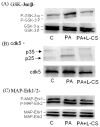Involvement of astroglial ceramide in palmitic acid-induced Alzheimer-like changes in primary neurons
- PMID: 17908174
- PMCID: PMC4059364
- DOI: 10.1111/j.1460-9568.2007.05797.x
Involvement of astroglial ceramide in palmitic acid-induced Alzheimer-like changes in primary neurons
Abstract
A high-fat diet has been shown to significantly increase the risk of the development of Alzheimer's disease (AD), a neurodegenerative disease histochemically characterized by the accumulation of amyloid beta (Abeta) protein in senile plaques and hyperphosphorylated tau in neurofibrillary tangles. Previously, we have shown that saturated free fatty acids (FFAs), palmitic and stearic acids, caused increased amyloidogenesis and tau hyperphosphorylaion in primary rat cortical neurons. These FFA-induced effects observed in neurons were found to be mediated by astroglial FFA metabolism. Therefore, in the present study we investigated the basic mechanism relating astroglial FFA metabolism and AD-like changes observed in neurons. We found that palmitic acid significantly increased de-novo synthesis of ceramide in astroglia, which in turn was involved in inducing both increased production of the Abeta protein and hyperphosphorylation of the tau protein. Increased amyloidogenesis and hyperphoshorylation of tau lead to formation of the two most important pathophysiological characteristics associated with AD, Abeta or senile plaques and neurofibrillary tangles, respectively. In addition to these pathophysiological changes, AD is also characterized by certain metabolic changes; abnormal cerebral glucose metabolism is one of the distinct characteristics of AD. In this context, we found that palmitic acid significantly decreased the levels of astroglial glucose transporter (GLUT1) and down-regulated glucose uptake and lactate release by astroglia. Our present data establish an underlying mechanism by which saturated fatty acids induce AD-associated pathophysiological as well as metabolic changes, placing 'astroglial fatty acid metabolism' at the center of the pathogenic cascade in AD.
Figures











Similar articles
-
Palmitic and stearic fatty acids induce Alzheimer-like hyperphosphorylation of tau in primary rat cortical neurons.Neurosci Lett. 2005 Aug 26;384(3):288-93. doi: 10.1016/j.neulet.2005.05.003. Neurosci Lett. 2005. PMID: 15939536
-
Palmitic acid-treated astrocytes induce BACE1 upregulation and accumulation of C-terminal fragment of APP in primary cortical neurons.Neurosci Lett. 2006 Oct 2;406(1-2):55-9. doi: 10.1016/j.neulet.2006.07.015. Epub 2006 Aug 9. Neurosci Lett. 2006. PMID: 16904262
-
Pioglitazone enhances pyruvate and lactate oxidation in cultured neurons but not in cultured astroglia.Brain Res. 2009 Dec 11;1305:64-73. doi: 10.1016/j.brainres.2009.09.098. Epub 2009 Oct 1. Brain Res. 2009. PMID: 19800324
-
Alzheimer's disease.Subcell Biochem. 2012;65:329-52. doi: 10.1007/978-94-007-5416-4_14. Subcell Biochem. 2012. PMID: 23225010 Review.
-
Decoding Alzheimer's disease from perturbed cerebral glucose metabolism: implications for diagnostic and therapeutic strategies.Prog Neurobiol. 2013 Sep;108:21-43. doi: 10.1016/j.pneurobio.2013.06.004. Epub 2013 Jul 11. Prog Neurobiol. 2013. PMID: 23850509 Review.
Cited by
-
Sphingolipids as prognostic biomarkers of neurodegeneration, neuroinflammation, and psychiatric diseases and their emerging role in lipidomic investigation methods.Adv Drug Deliv Rev. 2020;159:232-244. doi: 10.1016/j.addr.2020.04.009. Epub 2020 Apr 28. Adv Drug Deliv Rev. 2020. PMID: 32360155 Free PMC article. Review.
-
β-Amyloid1-42, HIV-1Ba-L (clade B) infection and drugs of abuse induced degeneration in human neuronal cells and protective effects of ashwagandha (Withania somnifera) and its constituent Withanolide A.PLoS One. 2014 Nov 21;9(11):e112818. doi: 10.1371/journal.pone.0112818. eCollection 2014. PLoS One. 2014. PMID: 25415340 Free PMC article.
-
Palmitate Compromises C6 Astrocytic Cell Viability and Mitochondrial Function.Metabolites. 2024 Mar 12;14(3):161. doi: 10.3390/metabo14030161. Metabolites. 2024. PMID: 38535321 Free PMC article.
-
High-Throughput Metabolomics for Discovering Potential Biomarkers and Identifying Metabolic Mechanisms in Aging and Alzheimer's Disease.Front Cell Dev Biol. 2021 Feb 25;9:602887. doi: 10.3389/fcell.2021.602887. eCollection 2021. Front Cell Dev Biol. 2021. PMID: 33718349 Free PMC article.
-
The complex relationship between obesity and neurodegenerative diseases: an updated review.Front Cell Neurosci. 2023 Nov 9;17:1294420. doi: 10.3389/fncel.2023.1294420. eCollection 2023. Front Cell Neurosci. 2023. PMID: 38026693 Free PMC article. Review.
References
-
- Arendt T, Bigl V, Tennstedt A, Arendt A. Neuronal loss in different parts of the nucleus basalis is related to neuritic plaque formation in cortical target areas in Alzheimer’s disease. Neuroscience. 1985;14:1–14. - PubMed
-
- Arvanitakis Z, Wilson RS, Bienias JL, Evans DA, Bennett DA. Diabetes mellitus and risk of Alzheimer disease and decline in cognitive function. Arch Neurol. 2004;61:661–666. - PubMed
-
- Beffert U, Cohn JS, Petit-Turcotte C, Tremblay M, Aumont N, Ramassamy C, Davignon J, Poirier J. Apolipoprotein E and β-amyloid levels in the hippocampus and frontal cortex of Alzheimer’s disease subjects are disease-related and apolipoprotein E genotype dependent. Brain Res. 1999;843:87–94. - PubMed
-
- Blazquez C, Galve-Roperh I, Guzman M. De novo-synthesized ceramide signals apoptosis in astrocytes via extracellular signal-regulated kinase. FASEB J. 2000;14:2315–2322. - PubMed
-
- Bligh EG, Dyer WJ. A rapid method of total lipid extraction and purification. Can J Biochem Physiol. 1959;37:911–917. - PubMed
Publication types
MeSH terms
Substances
Grants and funding
LinkOut - more resources
Full Text Sources
Miscellaneous

